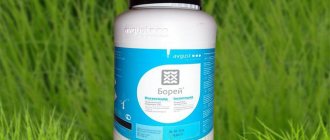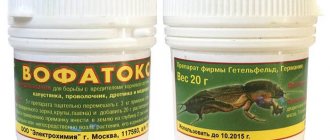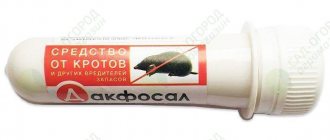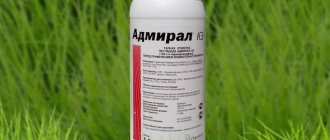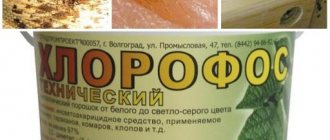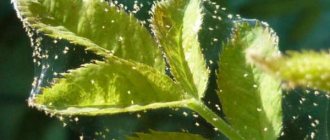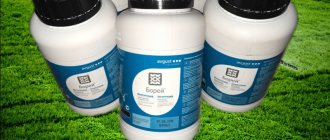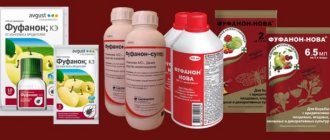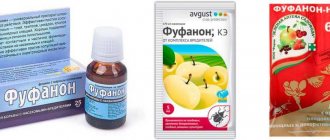The fight against harmful insects exhausts not only gardeners, but also the plants themselves. The new insecticide “BI-58” will help simplify the difficult work of the farmer, the instructions for use of which contain some features. It describes dosages for a wide variety of crops, and also lists groups of pests. In addition, it explains how to dilute the pesticide, what its shelf life is and how to spray the working solution on plants.
This product belongs to the category of organophosphorus compounds, since the active substance in it is dimethoate. Once on the surface or in the intestines of insects, it paralyzes living tissues. In the green mass of the crop, chemical bonds are maintained for 3 weeks, thereby protecting it from pests.
Mechanism of action of the drug
“Bi-58” is used on many crops to destroy aphids, caterpillars, flies, bedbugs, thrips, scale insects, moths, leaf rollers, codling moths, flower beetles, cutworms, gall midges, leafhoppers and some types of mites.
This insecticide has a powerful and complex effect. The solution is absorbed by leaves and green parts of plants and then spreads evenly. Pests die as a result of feeding on poisoned plant sap. The insecticide also acts by contact; insects die when the solution comes into contact with them after spraying.
Purpose
The preparations of the BI-58, KE series are developed and produced by the BASF concern, a world leader in the chemical industry. Used mainly in agriculture.
Has a wide spectrum of action to protect fruits, vegetables and ornamental crops from most insect pests:
- leaf rollers;
- gall midges;
- aphids;
- mites (spider mites, kidney mites);
- bedbugs;
- leafhoppers;
- scale insects and false scale insects;
- codling moth and leaf-eating caterpillars;
- stem flies;
- thrips and many others etc.
How to breed and use Bi-58
The instructions for use indicate that the drug can be used against a number of pests belonging to different orders. The product remains effective over a wide range of temperatures. The protective effect of the insecticide lasts 2-3 weeks. When used in the recommended dosage, it does not exhibit toxic effects on plants.
Application rate of "Bi-58" for various crops (in l per ha):
- wheat – 1-1.2;
- rye and barley – 1;
- oats – 0.7-1;
- apple, pear – 0.8-1.9;
- grapes – 1.2-2.8;
- vegetable crops for seeds – 0.5-0.9;
- potatoes from aphids - 2;
- moth control potatoes – 1.5-2;
- alfalfa for seeds, fiber flax – 0.5-0.9;
- hemp – 1.2-2;
- kenaf – 1.4;
- currants – 1.2-1.5;
- raspberries – 0.6-1.1;
- lupine – 0.7;
- sugar beet – 0.5-1.
See also
Instructions for use of Vidate and nematicide composition, dosage and analoguesRead
On all crops, except grapes, apples and pears, “Bi-58” sprays pests during the growing season, spending 200-400 liters per hectare. 2 treatments are carried out, the waiting period is 1 month for grains, grapes and beets, for apples and pears – 40 days. Fruit trees are sprayed before and after flowering, consumption - 1000-1500 l, against flower beetle - 800-1000 l. Grapes are treated against mites, leaf rollers and scale insects with a solution of 600-1000 liters per hectare.
Advantages and disadvantages of use
Among the advantages of using "Bi-58" it should be noted:
- Unique ratio - moderate toxicity for warm-blooded animals and strong contact and systemic insecticidal effect for insects
- Protective effect against all groups of insects, including plant mites
- No odor, almost no fumigant properties due to low volatility
- The drug has both contact and systemic activity
- Good compatibility with other pesticides
- No phytotoxicity, does not inhibit the plant
- Can be used over a wide temperature range
Disadvantages to consider:
- The high level of danger of the pesticide for bees requires the adoption of appropriate protective measures.
- Systematic use of BI-58, as well as other drugs based on dimethoate, causes acquired group resistance in insect pests.
Special instructions and precautions
"Bi-58" refers to drugs with hazard class 3 for humans, that is, low toxic. The product is highly toxic for bees and has an insect hazard class of 1. Due to the high toxicity of the drug, it cannot be used on flowering trees and in gardens near which there are apiaries. Also, this powerful drug is toxic to fish, so it cannot be used in areas with plants located near water bodies and fishing enterprises.
When working with the Bi-58 preparation, you must wear protective clothing, you need to wear long sleeves, gloves on your hands, a respirator and goggles on your face to protect your nose and eyes from splashes of the solution, which can cause irritation and poisoning. .
After finishing work on spraying “Bi-58” you need to wash your face and hands with warm water and soap. If the solution suddenly gets on your skin or eyes, you should immediately rinse them with plenty of water. If the insecticide gets inside, you need to rinse your stomach: drink activated carbon tablets, wash them down with 1 liter of water and after 15 minutes induce vomiting. If after self-treatment the symptoms of poisoning do not disappear, then you need to consult a doctor.
Composition and dosage form
Active ingredient: dimethoate , dosage 400 g/l, chemical class: organophosphorus compounds (OP). Preparative form – emulsion concentrate (EC).
Examples of manufactured drugs “BI-58 NEW, CE”
Interaction with other tools
"Bi-58" mixes well with fungicides, especially pyrethroids, in tank mixtures. Can be mixed with fertilizers for foliar feeding. The exception is products with an alkaline reaction. The combined use of Bi-58 and fungicides reduces the dosage and consumption of both drugs, without reducing the effectiveness. This makes their use economically profitable. It is recommended to mix the insecticide with the drug "Fastak" if treatment is necessary with a large number of pests.
See also
Instructions for using insecticide and pesticide Force, dosage and analoguesRead
Content
- Purpose
- Composition and dosage form
- Mechanism of action
- Regulations for the use of “BI-58, CE”
- Compatibility
- Analogues of “BI-25, NEW/TOP, EC”, preparations containing dimethoate
- Safety
- Advantages and disadvantages of use
"BI-58, KE" - insectoacaricide. Currently represented by two modifications: “BI-58, NEW, KE” and “BI-25, TOP, KE”. PV material purpose, composition, mechanism of action, regulations for use, dosage, safety, compatibility, etc.
Terms of sale and storage
The product should be sold and stored only in factory canisters with closed lids. “Bi-58” needs to be stored for 3 years in warehouses, at moderate temperatures, in a dry and shaded place. Do not store food, medicine or animal feed near the insecticide; only other agricultural products and fertilizers can be stored. Once the savings period has expired, its effectiveness is significantly reduced. The solution is suitable for use for only 1 day.
Precautions when working with the drug
- When working with such poisons, you need to be careful and use protective equipment: a respirator, goggles, rubber gloves.
- After treatment, wash and change clothes.
- The remaining solution must be disposed of.
- The drug is poisonous to bees, animals and fish, so you should not pour the remaining solution into water, or spray it during the flowering period of plants.
- The emulsion should be stored out of the reach of children and animals. Keep them away from the drug solution.
- Parts of treated plants can be consumed only a month after spraying.
- If you have symptoms of poisoning (nausea, dizziness, drowsiness), you should immediately call a medical team.
Are there any analogues of the insecticide?
For dimethoate, the following analogs of “Bi-58” are registered for use in agriculture: “Alfa-Director”, “Binadin”, “Binom”, “Bishka”, “Danadim Power”, “Danadim”, “Di-68”, “Dimetron”, “Dimefos”, “Evrodim”, “Sirocco”, “Tagore”, “Landing”, “Ditox”, “Tarradim”, “Dimet”, “Fostran”, “Kinfos”, “Tibor”, “Dimetoat” -400", "Tod", "Dishance", "Rogor-S", "Rangoli-Duncan", "Dimetus".
“Bi-58” is a well-known powerful insecticide that can be used to treat grains, vegetables, berries, fruit crops, grapes, and flax against a variety of pests. Its action is complex: systemic, contact and intestinal. Because of this, the insecticide has strong effectiveness and a long-lasting protective effect. The drug is compatible with many pest control agents, some of them are even recommended to be used together to enhance the overall effect.
Advantages
The main quality of this insecticide is the effective destruction of most types of insects. Only this criterion can maintain the reputation of a truly good product for many years. For three weeks, BI-58 moves freely inside the plant with its juices, penetrating the stems, leaves, and new young shoots. Kills pests quickly and reliably without repeated treatments during this period.
It is also in demand because of its versatility: the range of applications is very wide. The product is accompanied by instructions describing in detail all its properties and dosage for spraying. This is convenient when one product is suitable for many crops and completely different insects.
Application area
The systemic drug was developed to combat insects in large and small agricultural farms. The chemical shows good results against both adult forms and larvae. “BI-58” is effective against the following pests:
- caterpillars;
- ticks;
- codling moth;
- nematodes;
- aphids;
- thrips;
- scale insects;
- leaf roller.
Insectoacaricide helps to cope with parasites in greenhouses, greenhouses and indoor plants. A high concentration of the working solution often leads to burns on flowers and decorative species. To avoid problems, you need to strictly follow the dosage of the poison.
Reviews
Arkady Krylov, Samara:
The garden is constantly attacked by insects: either a nematode spoils the strawberries, or a spider mite sticks to the roses, or the Colorado monster leaves them without potatoes. The wife spied blue vials with a strong poison - bi58 - at the neighbor's house. I wanted to buy it. I was getting ready to go to my favorite Leroy Merlin.
And I read a lot about this chemistry and forbade poisoning the soil with plants. Is it worth fighting pests at such a price if the fruits can become a source of mortal danger? It would be better if I poured copper sulfate on the trees and bushes in early spring and then in the fall.
Steblinsky Peter:
I have been gardening for almost half a century. Acquired useful acquaintances. A farmer friend said that he uses the German “BI-58” for pests, they say, it helps a lot. I asked a friend-seller what kind of product it was. He suggested what to replace the drug with, since this one contains strong poisons and is not suitable for gardens.
Pharmacology
Liv.52 is a hepatoprotector based on a complex of plant substances. It affects the liver, renewing the regenerative processes of hepatocytes, stimulating the biosynthetic function of organ cells and the secretion of bile. Thus, it protects the parenchymal organ from the influence of toxic compounds that have penetrated the body, inhibits the oxidative degradation of lipids and the effects on liver cell membranes. Removes signs of motility disorders of the gallbladder, its ducts and sphincters. The pharmaceutical product promotes food digestion, increases appetite, eliminates inflammatory processes, and creates a mild diuretic effect.
Consumption rate
The dosage of “BI-58” depends on the type of plant and the size of the area. To treat potatoes against parasites, you need to use 2 liters of working solution per hectare. To spray stone fruit trees you will need 80 ml per 100 squares. 1.5 liters of toxic liquid in standard concentration is used to protect:
- hops;
- barley;
- rye;
- oats;
- wheat.
“BI-58” against mites, leaf rollers on grapes and currant bushes, raspberries, and gooseberries is used in a volume of 1 liter. To protect legumes, beets and alfalfa from parasites, you need to use 500 ml of the chemical. The consumption rate for mulberries is 3 l. The amount of solution is indicated per 1 ha. Carefully spray decorative and indoor species with poison, using the lowest concentration.
